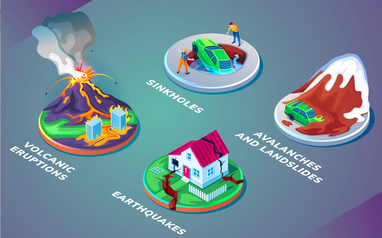Geophysical Hazards
|
|
|
Introduction to the Unit
This optional theme focuses on geophysical hazard events. This includes internal earth processes, such as earthquakes and volcanic activity. It also encompasses mass movements such as landslides, rockslides, debris or mud flows. The theme also includes human impacts and responses. Case studies of contrasting geophysical hazard events need to be undertaken (“contrasting” can be interpreted as the severity of impacts and/or locations with different socio-economic realities):
- two earthquake hazard events of similar magnitudes but with contrasting human impacts
- two volcanic hazard events in contrasting plate boundary locations
- two mass movement hazard events with contrasting physical characteristics (fast/slow; solid/loose).
Through the study of this optional theme, students will develop their understanding of processes, places, power and geographic possibilities. They will additionally gain an understanding of more specialized concepts including risk and vulnerability (both of which vary according to the local context) and also resilience and adaptation (in relation to pre-event and post-event disaster management).
- two earthquake hazard events of similar magnitudes but with contrasting human impacts
- two volcanic hazard events in contrasting plate boundary locations
- two mass movement hazard events with contrasting physical characteristics (fast/slow; solid/loose).
Through the study of this optional theme, students will develop their understanding of processes, places, power and geographic possibilities. They will additionally gain an understanding of more specialized concepts including risk and vulnerability (both of which vary according to the local context) and also resilience and adaptation (in relation to pre-event and post-event disaster management).

